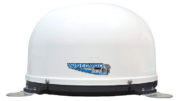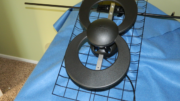This article originally ran in 2017. I’ve rewritten it to try to explain things a little better.
The photo above is Alexander Graham Bell. He gets the credit for inventing the telephone, although it’s possible he doesn’t deserve it. Still, history is written by the winners, and it was the Bell Telephone Company that dominated the world of communications in most of the 20th century. They evolved into AT&T, a company that’s still shaping a lot of our communications today. And, he’s the reason we have decibels.
How is Bell related to the decibel?
Since most electrical terms (volt, ampere, ohm, etc.) are named after pioneers in electricity, it seems natural that the bel was named after Alexander Graham Bell. A decibel (dB) is one tenth of a bel, and is the more useful measurement. But what is a decibel?
A decibel isn’t something you can smell or taste — it’s a unit of change. It can’t tell you how much of something you have, it can tell you how much more of something you have. It’s all relative, you see — and the easiest way to understand this is to use decibels to measure sound, which is where people tend to run into them in the first place. With sound, 0dB is relative silence. It’s not the total absence of sound, it’s the most silent you can get it our atmosphere. Space would be the total absence of sound because sound can’t travel without air.
The funny thing about decibels is that they measure things in a way which will probably make no sense to you but it really helps with measuring things like current, voltage, pressure, and yes… sound.
Decibels are different, and they’re all the same
Because the decibel is a unit of relative change, you can have different kinds of decibels that have nothing to do with each other. When you use them to refer to sound, those are dBA (decibel audio.) Use them to refer to signals over a wire, and they’ll be referred to as dBm, dbµV, or dBmV, depending on whether they are relative to one watt or one volt. And if they’re measuring antenna performance, that’s dBi or dBd, which is a little harder to explain. Maybe I’ll do another whole article at some point.
How decibels actually work
Follow along for a second. 10dB, that’s 10 times as much (pressure, voltage, sound, whatever.) 20dB, that’s 100 times. If you have a 2-digit number of dB’s, the first digit is the number of zeroes you put after the one. 50dB, that’s a one with five zeroes, or 100,000 times as much. Yes, it’s true, that will tear up your brain if you try to think about it too hard, but you need to measure stuff using this weird scale in order to really understand it. A sound that’s 50dBA has 100,000 times more power to the sound waves than the waves you find in a theoretically silent room. (There’s no such thing as a truly silent room. The closest is an anechoic chamber.)
Decibels are designed to make it easy for you to work with wildly different numbers. Instead of trying to compare, for example, .1 watt with .000001 watt, you just say 100dbm and -40dBm. (0dBm = .001 watt, or 1 milliwatt.) You can add and subtract dBs easily, so you can say that a sound that’s 40dB is 100 times more powerful than one that’s 20dB, because 40-20=20, and 20=100x. Keep up, it doesn’t get easier but it will be over soon.
How this applies to signals
The same theory applies to electricity and signal but when we are measuring signal we put an extra letter or two after the dB to tell us what we’re measuring against. If you see dBw, that’s measuring how much signal you have relative to one watt. If you see something measured in dbµV, that’s relative to one microvolt (the little µ means “micro.”)You tend to see negative numbers in signal, but that just means you’re less than 1 of whatever you’re measuring. -30dBm is less than one milliwatt, in fact it’s 1/1000th of a milliwatt (again the -30 means a one with three zeroes after it.)
You can also measure signal strength of an antenna in dBi or dBd, both of which measure the strength of this particular antenna compared to a reference level. It’s a way to compare antennas that makes for a little more level playing field.
It’s pretty amazing how versatile that little decibel is, because you can use it to measure almost anything. Most of our blog team, for example, would like about 40dB$, which is a made up term around the office for $10,000. See, you can apply decibels to anything!
Still confused?
If you have a question about decibels, or anything else that refers to electronics, call the experts! The team at Solid Signal is full of trained technicians who are ready to help you find the answers you need. We’re here for you during East Coast business hours at 888-233-7563. If it’s after hours, just fill out the form below! We’ll get back to you as quickly as possible, generally within 10 decibel-day (one day.)





